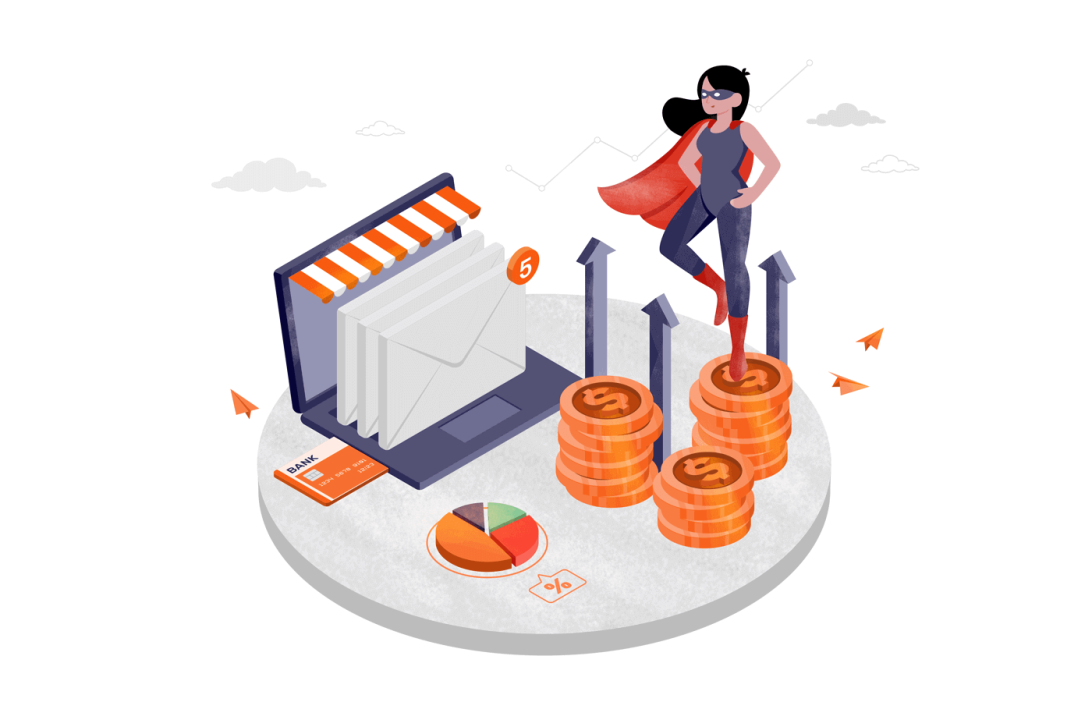You’ve mastered promotional email blasts, but are you truly making the most of ecommerce email marketing? Keeping up with the latest email trends for ecommerce is great, but it’s not enough to get the best email campaign ROI for online stores.
To truly stand out, you need innovative email strategies for e-commerce that engage subscribers and drive sales.
Whether you’re utilizing the convenience of Shopify email marketing integration or exploring the robust features of dedicated ecommerce email marketing software, this article reveals tried and tested tactics to refine your ecommerce email campaigns approach.
Get ready to move past the online business email marketing fundamentals and watch your sales climb! Even if you come from B2B, you’re sure to find something useful. Let’s dive in!
18 Ecommerce Email Marketing Strategies
Ecommerce email campaigns come in all shapes and forms, from ecommerce transactional emails and automated email campaigns to ecommerce email sequences.
Let’s look at the most popular ecommerce email examples to inspire your own ecommerce email marketing strategies:
Create an Engaging Welcome Email
Welcome emails are an essential part of drip email campaigns for ecommerce. And a great way to start a relationship on the right foot. Think of it as a chance to create a solid first impression. Think of welcome email sequences as a part of your user onboarding process that will compel them to try you out.
Take the following email by Tea Collection, for example:
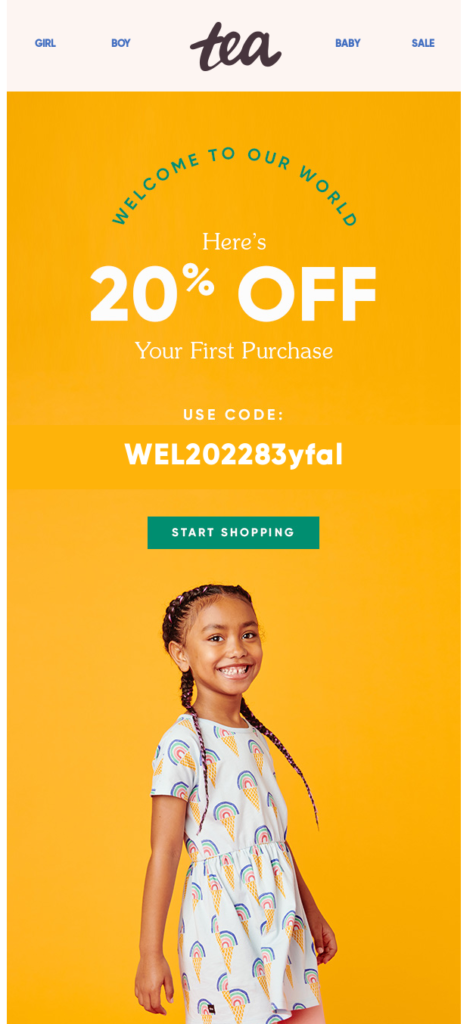
Notice the vibrant color theme with a discount coupon highlighted right on top. This tells that the brand cares about the new signup and wants them to try the product. The subject line (Welcome to Tea! Get 20% off) and preheader text is equally compelling.
Key Takeaways
- 74% of people are expecting to receive an email immediately after they subscribe to your list;
- Use a vibrant and inviting color theme;
- Offer value upfront (discount offers, exclusive deals, or downloadable);
- Showcase your offerings in your welcome email.
With Sender, it’s simple, quick, and affordable. Do everything from capturing leads to nurturing them within one dashboard – starting at the price of a pizza.
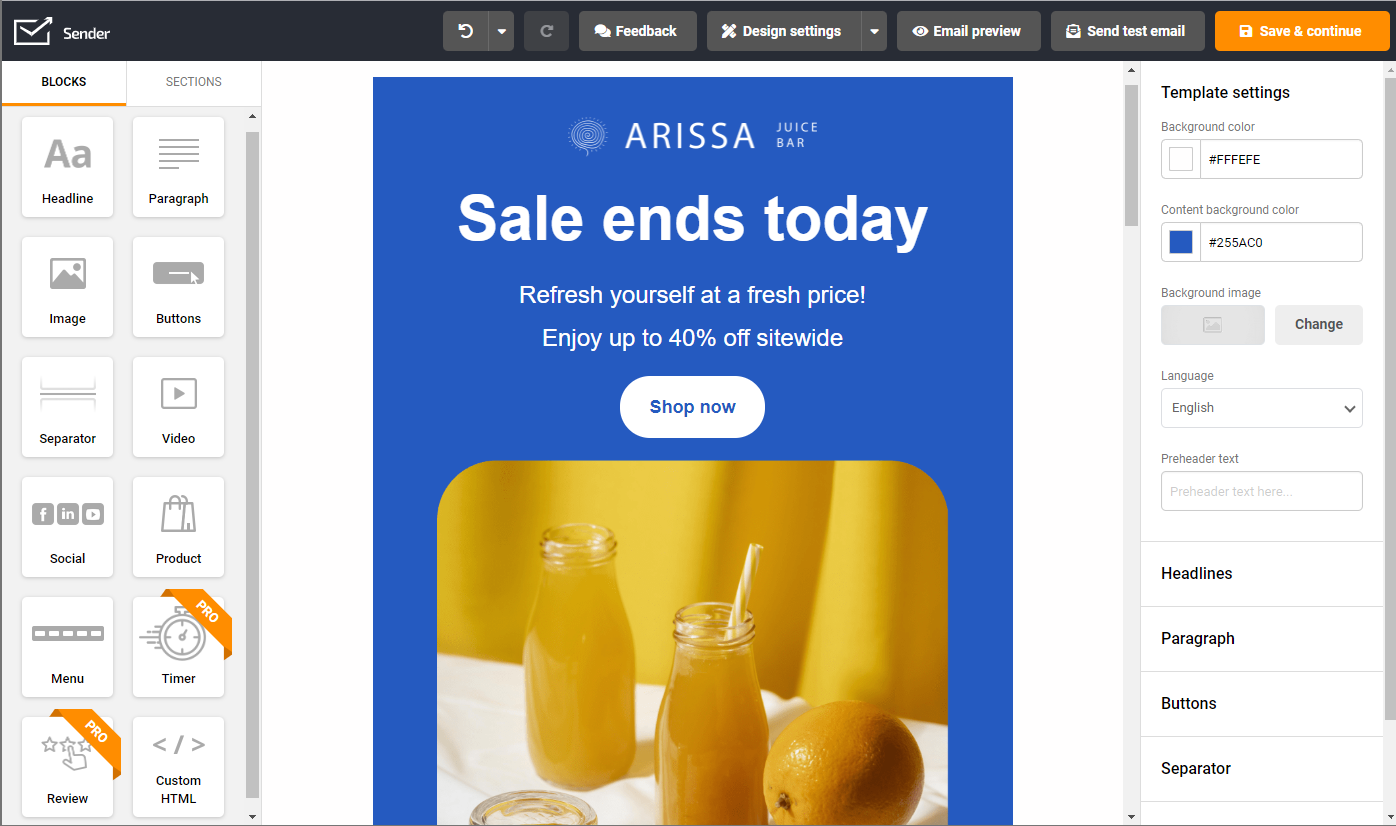
Recover Abandoned Carts with Emails
People live busy (and distracted) lives and sometimes forget to check out because of the Insta notification or an important call. Abandoned cart recovery emails should remind them to check out at ecommerce stores. Take this engaging email example by Varley:
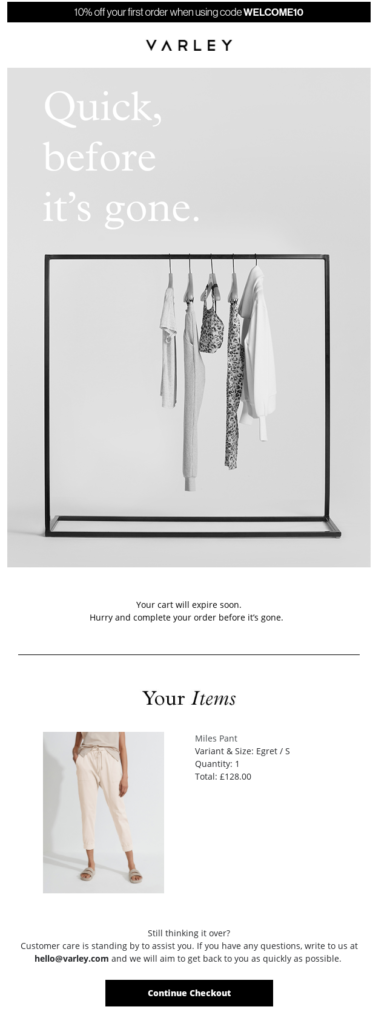
The email’s subject line – ‘Quick, before it’s gone is an excellent example of creating a FOMO + urgency effect all at once. The simplistic email design with an exclusive offer and an option to talk to customer care is definitely impactful.
Key Takeaways
- 21% of readers click through cart abandonment email and 50% of those decide to finish their purchase;
- Keep the email design simple with a spotlight on abandoned products;
- Give the option to connect with customer care in case of queries;
- Share your exclusive deal or offer in case they want to come back and buy from you.
Request Reviews with Email Campaigns
Follow up with existing customers 1-2 weeks after delivery to gather valuable feedback. Send a friendly email inviting them to review their recent purchase.
These emails provide invaluable information on how you can improve your products or what customers liked in your productions that others could too.
Here’s a good example of a review request email from Evergreen Juices:
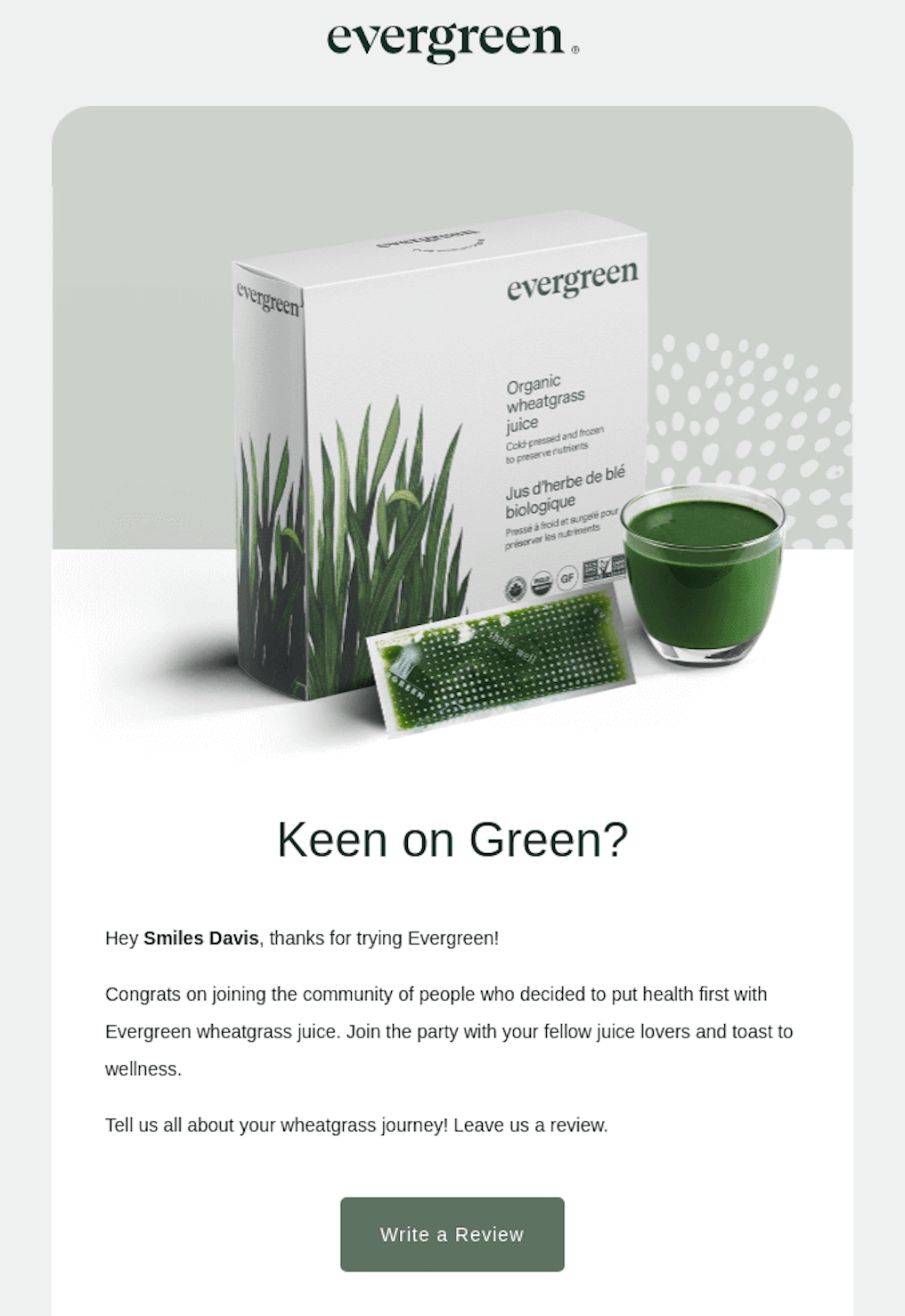
Evergreen Juices sends its review request two weeks after the order has been delivered—the right time when a person has already tried the products and can tell about their benefits (or lack thereof).
Key Takeaways
- Ask for the review when the experience is still fresh in the customer’s mind;
- Thank for buying from you so that the customer would be more willing to leave a review;
- Make the CTA clear and stand out so even the readers who usually skim the email will see it.
Gather Feedback or Surveys Through Emails
Surveys are a great market research tool to know what your customers want. And what’s a better way to know what they want than asking them directly? Survey emails are meant to gather insights, like the following email by ryka:
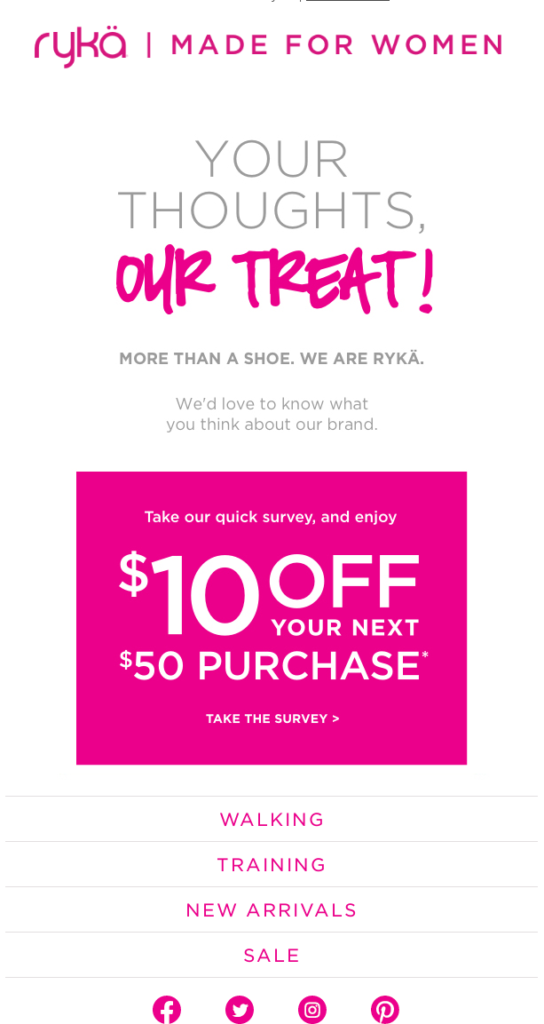
The email is refreshing, thoughtful, and on-point. It also shares a special incentive – $10 off on the next purchase for everyone who completes the survey.
Key Takeaways
- Incentivize survey responses by sending a discount voucher or coupon code to successful respondents;
- Be clear and upfront about what the survey is about;
- Have an engaging email copy + CTA to encourage readers to participate in the survey.
Re-Engage Your Audience with Targeted Emails
No matter how good you are at emails and creating a solid value proposition, some subscribers would stop buying from you, not open your emails, or engage with you after a point.
It’s when special ecommerce email marketing campaigns come into play – re-engagement email campaigns. Here’s how Netflix does customer retention through email:
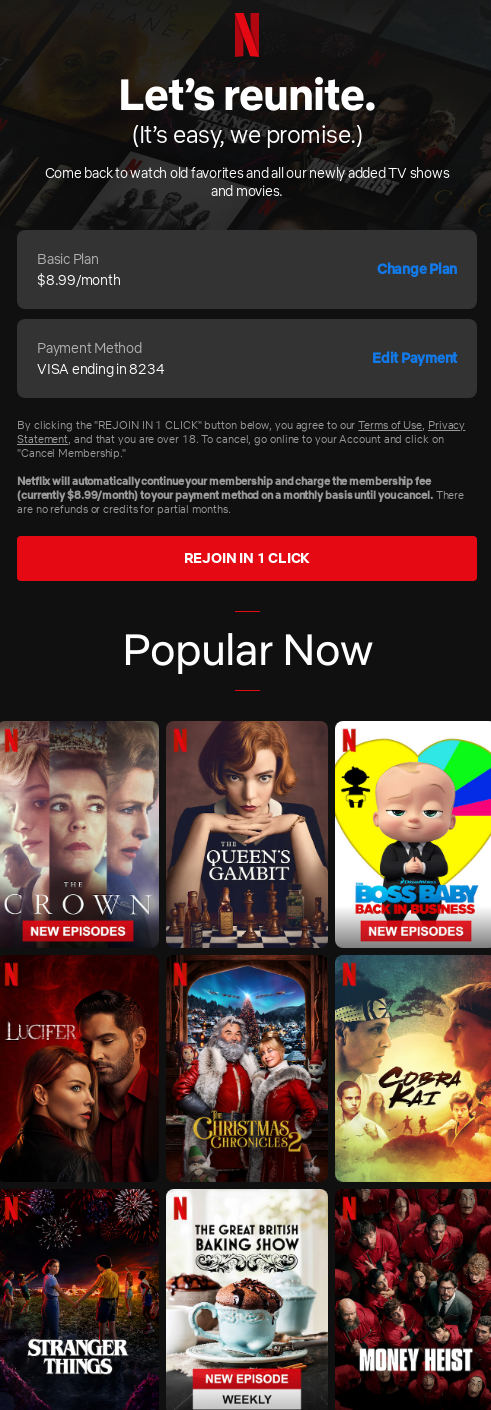
The email tries to lure inactive users into subscribing to Netflix’s paid plan. The header – Let’s reunite, along with an inline form to rejoin, is an excellent attempt at reducing the number of steps it takes to return.
Key Takeaways
- 45% of recipients who received re-engagement emails read subsequent emails.
- Make it easy for repeat customers to come back to your brand;
- Remind them about the reason why they loved you in the first place;
If you’re using an email marketing tool that offers email automation for ecommerce, ensure you set up a whole re-engagement sequence.
Win Back Customers with Strategic Emails
Win-back emails are an attempt to bring attention back to your brand. Most consumers forget about your brand after a while. A win-back campaign helps remind them about you and is a great chance to register repeat sales.
Take the example of this win-back email by Sunbasket:
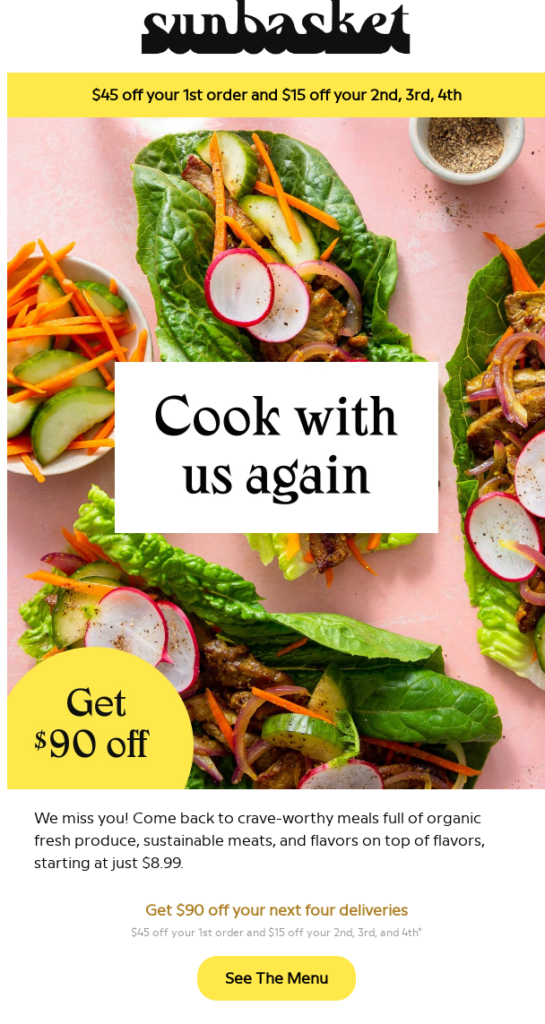
The email copy with a subtle tone of ‘nostalgia’ and ‘craving’ is on-point. The header ‘cook with us again’ aims to remind the reader about the joy of using the brand’s product. The exclusive offer with a contextual is an excellent attempt at encouraging the user to click the link.
Key Takeaways
- Remind them about the reason why they signed up in the first place;
- Add an exclusive or no-brainer offer to come back;
- CTR in email marketing is essential, so use contextual CTAs and email copy to encourage clicks.
If you’re interested in more win-back email campaigns, check out these 10 We Miss You email template examples & subject lines.
Show Appreciation with Thank You Emails
Your customers are the greatest in the world and deserve appreciation. Show it by sending them a thank you email. Whether after placing an order, leaving a review, becoming a loyal customer, or just because, the receivers of a warm ‘thank you’ will feel seen and valued.
Don’t tell us you wouldn’t wish to get this email from Wonder Valley:
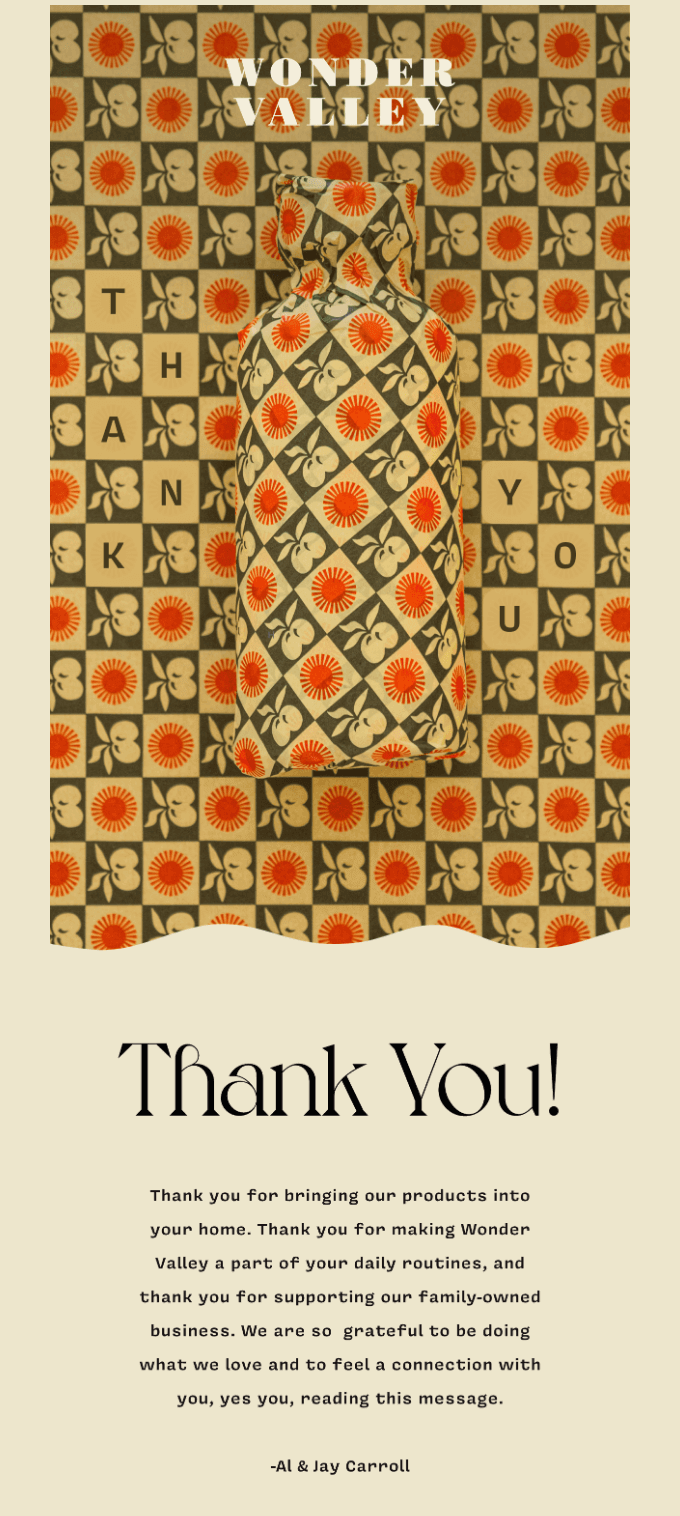
Wonder Valley didn’t need any special occasion to send its thank you email. The brand simply wanted to thank its customers for supporting their ecommerce business (and continue to do so).
It turned out to be an excellent way to make the customers feel that their choice was right and to remind them about the benefits of the brand’s products.
Key Takeaways
- Be clear on why you’re thanking your customers;
- Use a thank you email as an opportunity to ensure that customers were right for choosing your products;
- Dedicate the ‘thank you’ from a real person to make it more genuine;
- Add an incentive like a discount or offer to motivate customer retention.
Build Customer Loyalty with Email Campaigns
Want to keep your best customers coming back for more? That’s where customer loyalty emails come in. They’re a key part of any smart ecommerce email marketing strategy because they make your VIPs feel appreciated, improving customer retention in the long run.
We’re talking exclusive perks, early access to sales, personalized recommendations – even a simple birthday greeting goes a long way!
It neither has to be something grandiose as Barista & Co’s email proves:
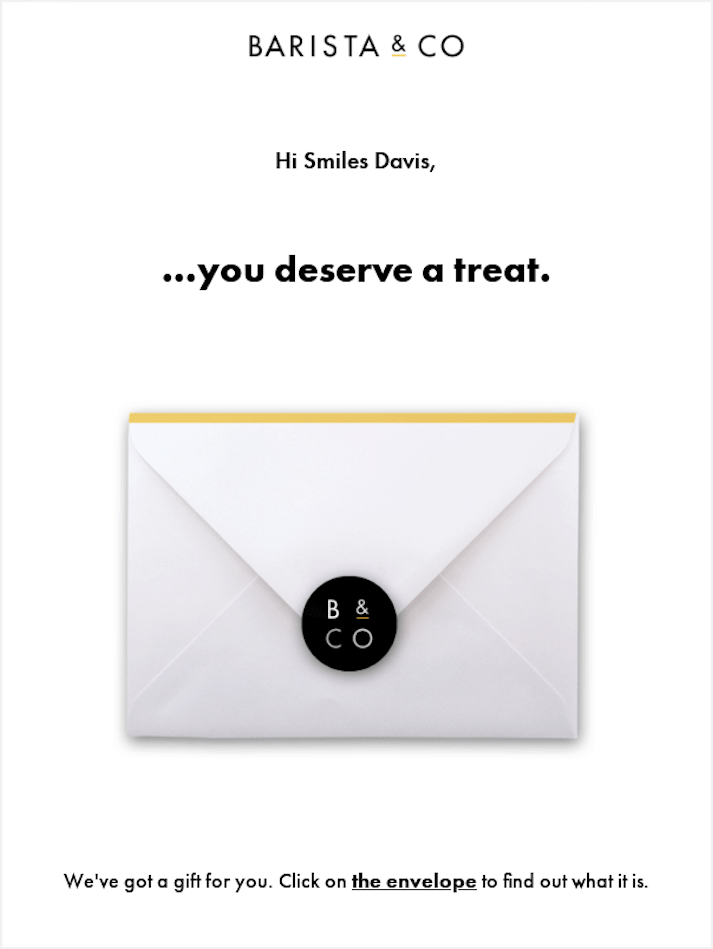
The brand surprised its loyal customers with a bit of appreciation ‘just because’ — no special occasion, big purchase, or milestone attached. This simple gesture went a long way in strengthening relationships and keeping the brand top-of-mind.
Key Takeaways
- Show appreciation to your loyal customers not only when they purchase from your brand;
- Make it all about your customer, not your brand or products;
- Ensure that the perk you’re gifting is valuable;
- Don’t ask for anything in return.
Stop worrying if your email looks good on other devices. With Sender’s ecommerce email marketing platform, you get free responsive email templates that look good on any screen!
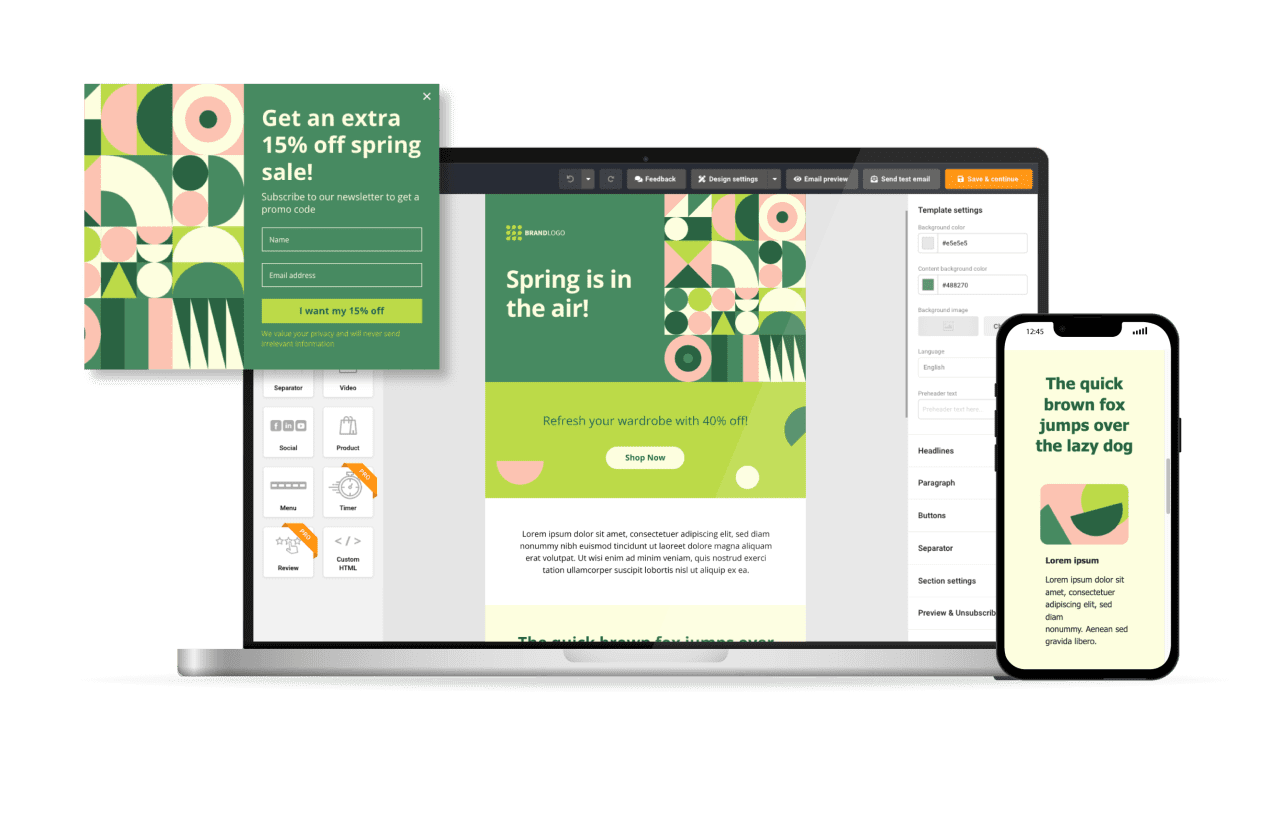
Leverage Seasonal Events to Increase Sales
Want to boost sales in your ecommerce store? Tap into the holiday spirit! Holiday email marketing campaigns are a fantastic way to get people excited and shopping. Think Christmas, Valentine’s Day, or even back-to-school. Target your discount and coupon emails for ecommerce around these events, making them feel exclusive and valuable.
Use email segmentation strategies to offer targeted deals to different customer groups – maybe free shipping for first-time buyers or early access to sales for loyal subscribers. Don’t forget to make your ecommerce email marketing campaigns festive and fun!
Here’s one of the best seasonal sale emails we’ve seen this year – De La Calle’s end-of-summer newsletter:
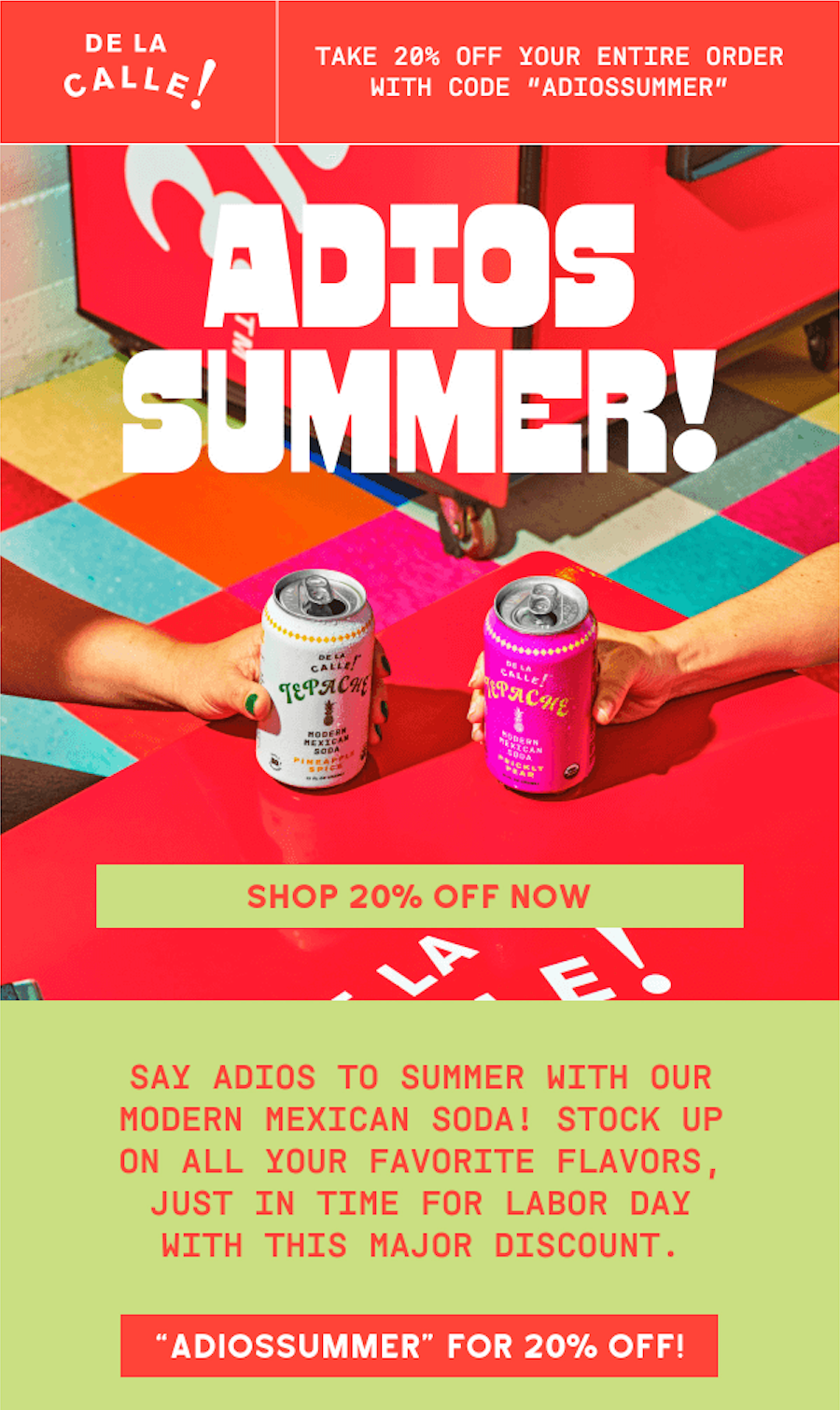
Key Takeaways:
- Choose email templates for ecommerce that ‘scream’ the season;
- Create a CTA that immediately lures into your online store;
- Use an email marketing tool to save you time on quality, not quantity.
Confirm Purchases with Order Confirmation Emails
Order confirmation emails reassure the customer that everything’s okay – they are sent straight after the order is placed. These emails are a great way to create an impression that you pay attention to detail and set expectations correctly. Look at the following order confirmation email from Harry’s:
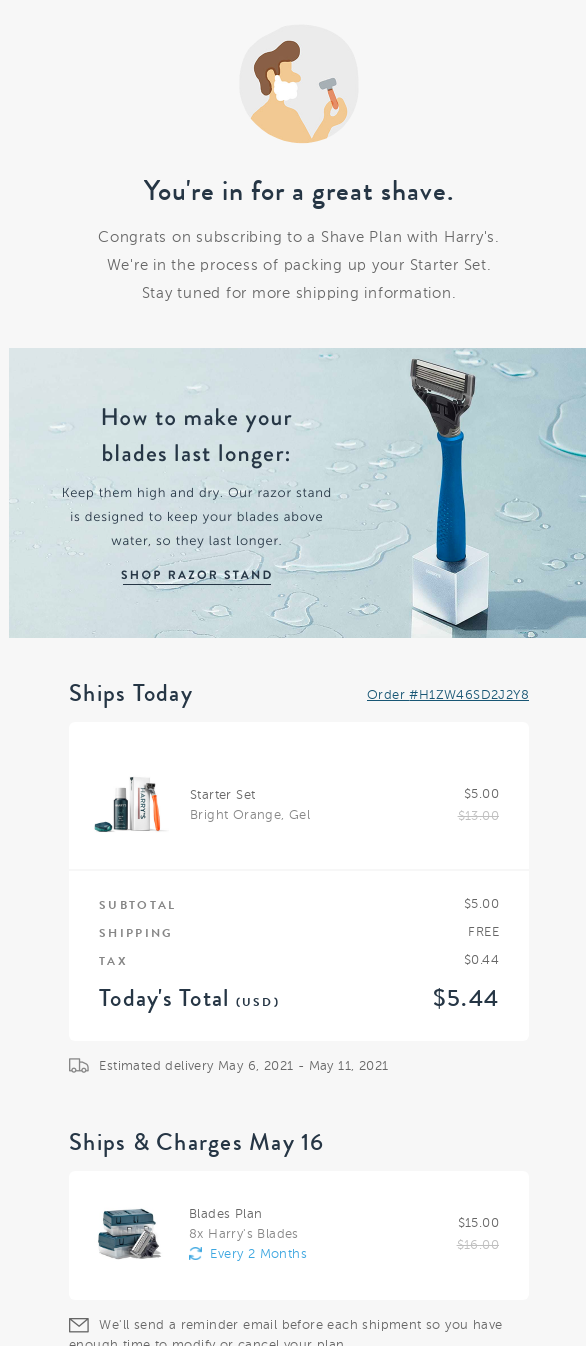
The subject line (‘Introducing your shave plan’) and the header are good examples of how you should introduce things to your buyers. The email also has shipping details and a special ‘tutorial-type’ blog to ensure the product lasts longer.
Key Takeaways
- Be direct and clear about order number, shipping dates, and key information;
- Introduce them to other offerings (or upsell) within your order confirmation email;
- Set up automated email workflows for timely communication;
- Use a simple yet powerful subject line.
Notify Customers with Shipping Confirmation Emails
Another step in reassuring customers that everything is going great is shipping confirmation emails sent when the order is already underway. Usually, these emails inform the customer when they can expect their shipment and remind them of the order details.
Take a look at the example from Haoma:
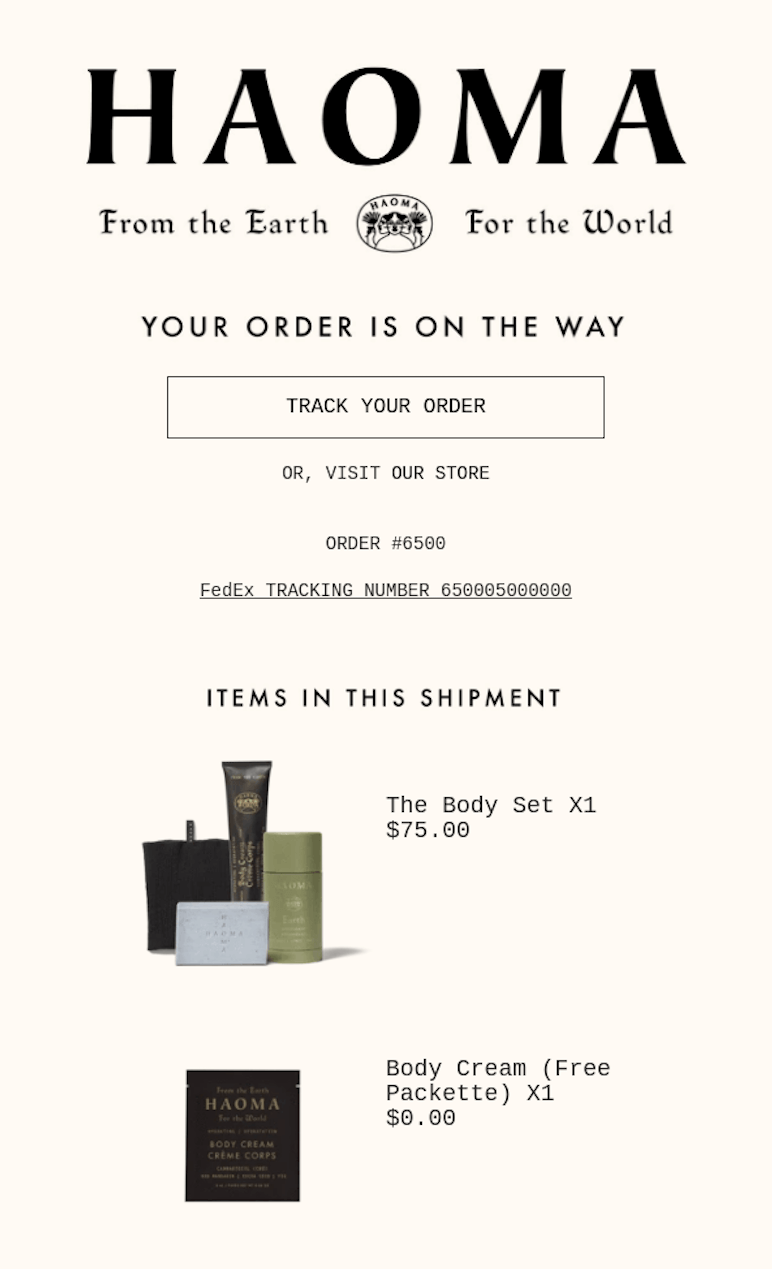
The brand manages to nicely fit all the order information in a single email: the shipment details, tracking link, and what’s included in the order. The receiver understands what it is about in a single glance and can track their order in real-time.
Key Takeaways
- Be straightforward with your subject line – “A shipment from order #XXX is on the way” is perfect;
- Remind the subscriber about the order contents to avoid any misdirections;
- If possible, include a live tracking link so the reader can stay updated on the delivery progress
Confirm Deliveries with Delivery Confirmation Emails
The third-in-line email after an order has been placed is a delivery confirmation email informing the customers that their orders have been successfully delivered. While not necessary (most of the time, the customer already knows as they have the order in their hands), it can still be valuable.
The customer may not have gotten the delivery and should have looked around it. Or they have complaints about the order and need to know whom to contact. It’s precisely what Laird had in mind when they created its email:
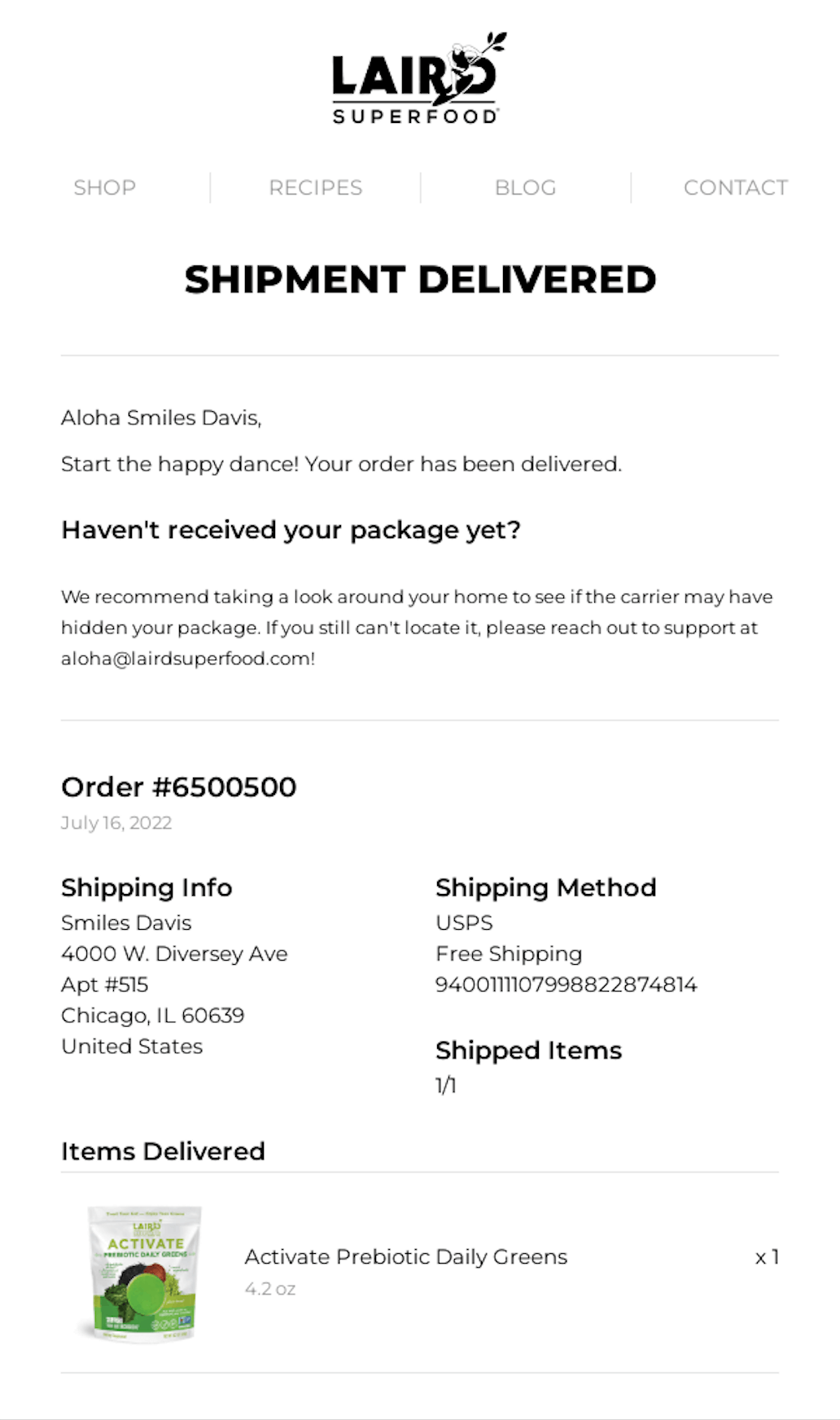
Laird’s email begins on a high note – it’s time to be happy as your order has been delivered! However, it has other important components too – informing the customers that they should go looking for their parcel if they haven’t actually received it and contact information if they don’t find it.
Key Takeaways
- Inform that the email is about successful delivery already in the subject line;
- Include all the order details the customer could possibly need;
- Give contact details in case something went wrong with the order.
Alert Shoppers with Back-in-Stock Emails
Back-in-stock emails are a bit of a forgotten trick in the book of email marketing for online stores, however unrightfully so! As the name suggests, these emails are sent when a product is restocked.
The message “back in stock” signals your customers that it’s a popular product they should get their hands on quickly (why else would it have been sold out?).
Athletic Brewing knows how to do these types of emails right:
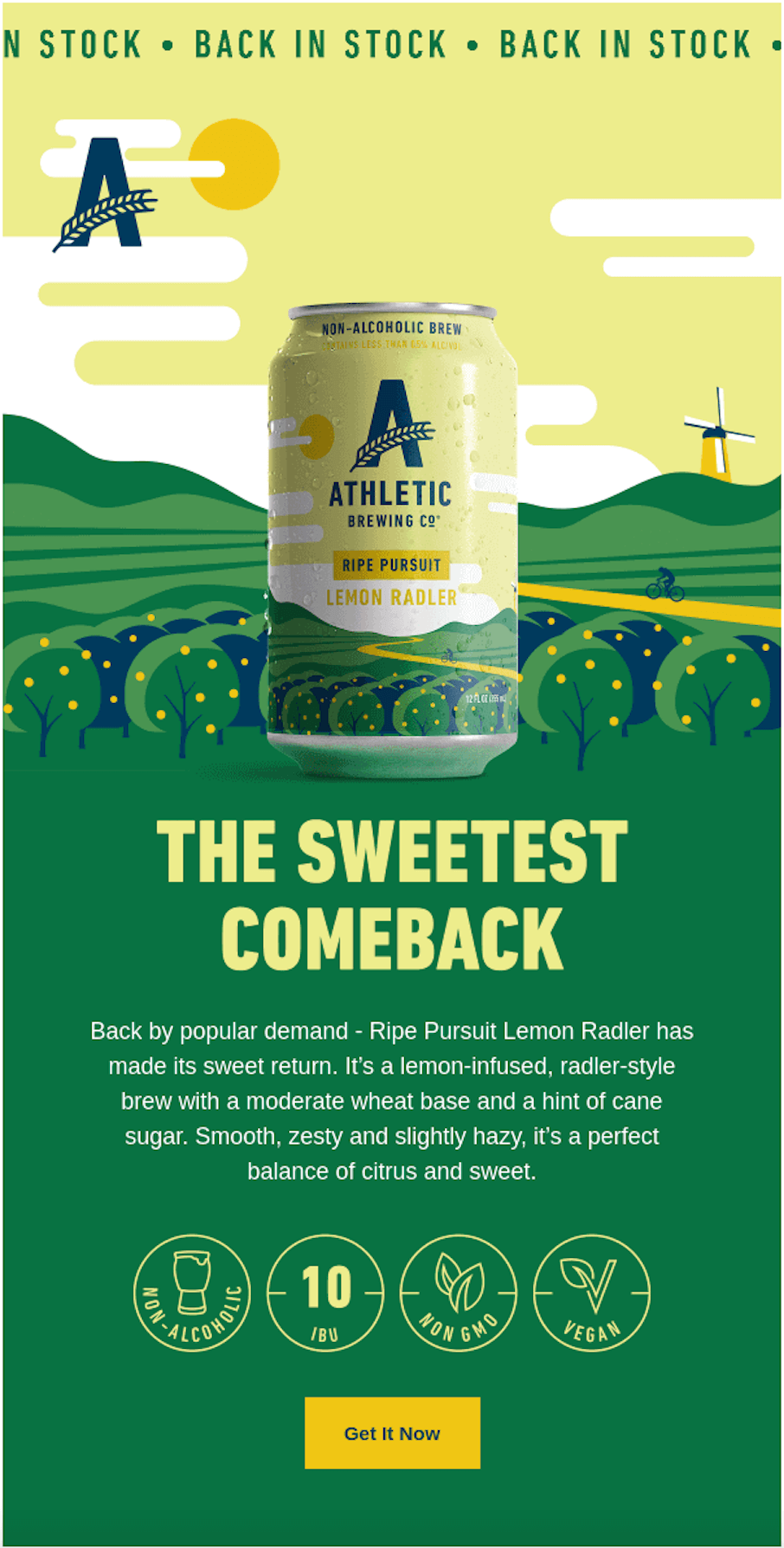
By cleverly revealing that its product has been restocked due to popular demand, the brand sparks curiosity about why it sold out initially, creating a sense of intrigue and urgency to try it.
Moreover, the brand takes the opportunity to highlight the product’s key features and benefits, reinforcing the customer’s desire to purchase. This strategic approach not only rekindles interest but also effectively communicates the product’s value proposition, making it a highly effective ‘back-in-stock’ email.
Key Takeaways
- Back-in-stock alert emails achieve a 22.45% average conversion rate;
- Explain why the product is restocked beyond that it was sold out;
- Repeat the features and benefits of the product;
- Create a sense of urgency, mentioning that it might be out of stock again soon.
Encourage Repeat Purchases with Replenishment Emails
When it’s time to restock beauty or cleaning supplies, your customers might get a friendly nudge from you through a replenishment email. These emails are set up to automatically ping your audience when it looks like they’re running low or might need a refill soon.
Usually, these emails are well-perceived as they work as gentle reminders to get more of one’s preferred products. Knowing this, Dollar Shave Club has mastered replenishment emails:
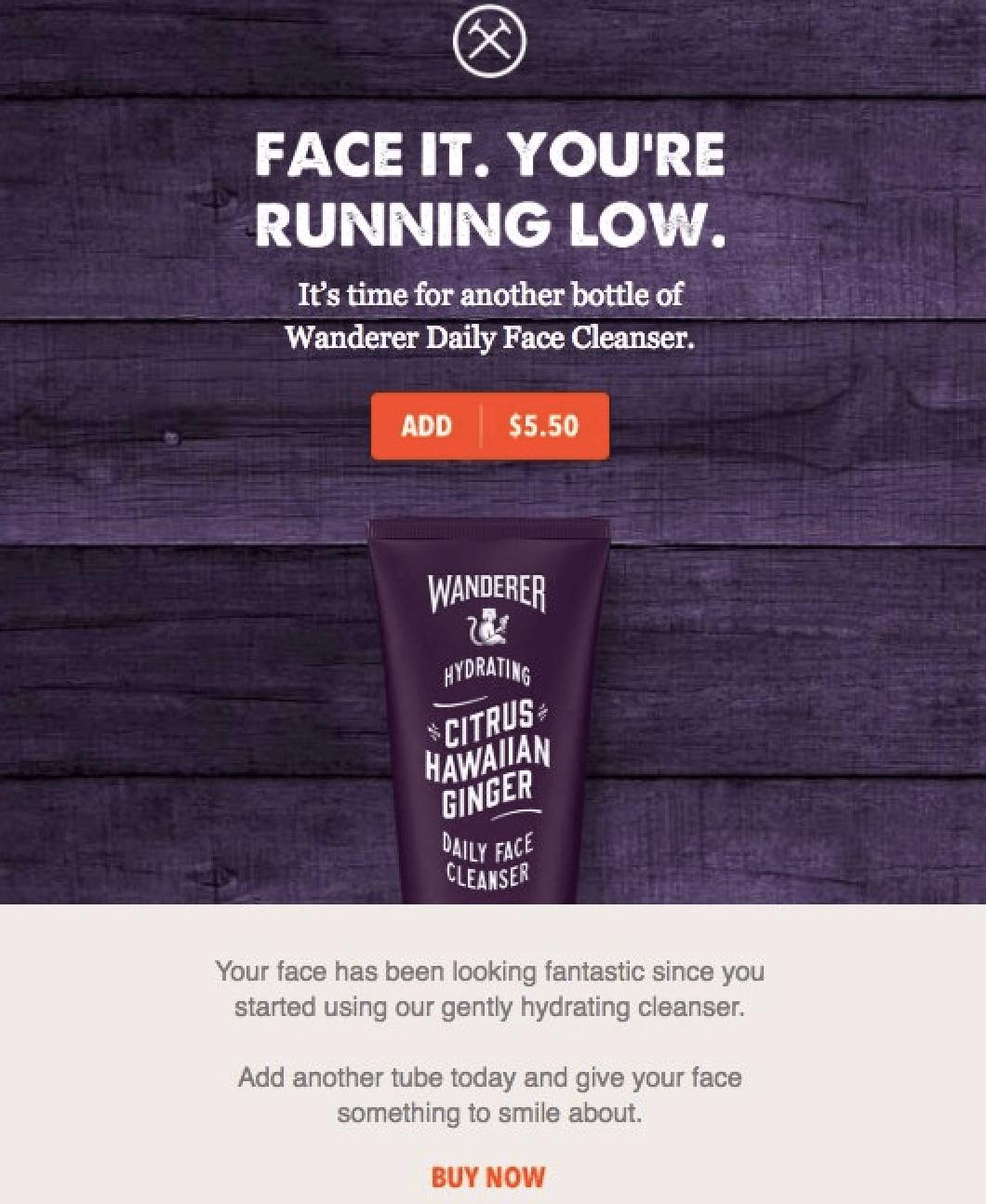
By sending a ‘time to restock’ email, Dollar Shave Club secures the sale and prevents customers from purchasing elsewhere. They take it further by reminding recipients of the product’s original benefits, initially persuading them to buy.
- Use data to determine the best time to send the replenishment email;
- Personalize the email for a bigger impact;
- Make reordering of the product as easy as possible;
- Remind the product’s benefits, proving it’s a viable repeat purchase.
Upsell and Cross-Sell with Targeted Suggestions
Upselling and cross-selling emails are a great way to increase customer lifetime value and boost customer loyalty.
Upsell emails try to persuade users to buy a more expensive or premium version of the product they have already purchased. In the meantime, cross-sell emails offer related or complementary products based on customers’ recent purchases.
Take a look at the cross-sell email email by Timberland:
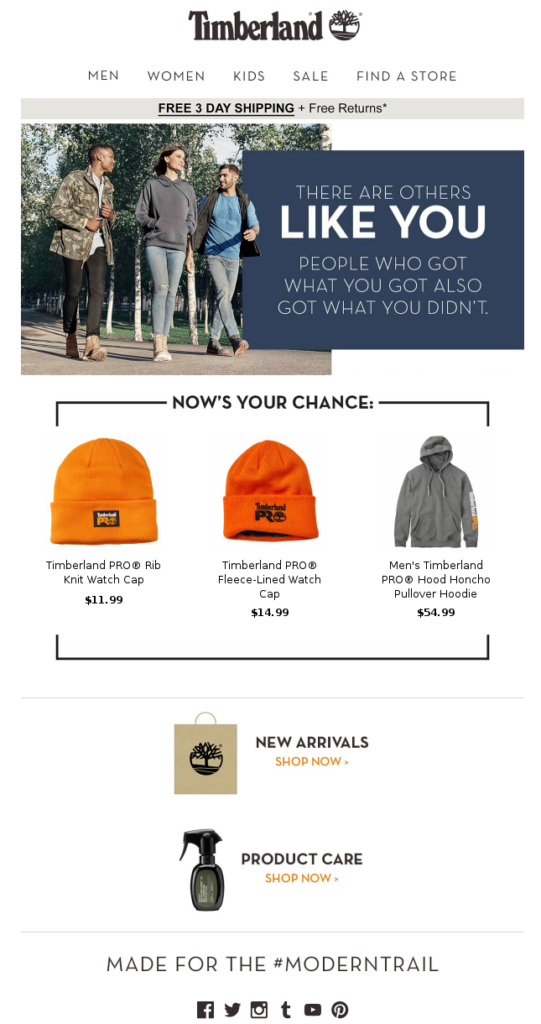
The email opens on a relatable note and shares what can be exciting for the user. It’s contextualized based on recent purchases and shares complementary products that might be relevant for the recipient.
Key Takeaways
- Upselling and cross-selling are responsible for 10-30% of ecommerce revenues;
- Always share personalized shopping recommendations within cross-selling and upselling emails;
- Follow up with cross-sell or upsell recommendations within 1-2 weeks to capitalize on the positive experience with previously purchased products;
- Provide an incentive or discount coupon, if possible.
Promote Discounts Through Email Campaigns
Discount emails are promotional emails where you share information about your ecommerce store’s latest sales or discounts. Look at the following example by Nine West:
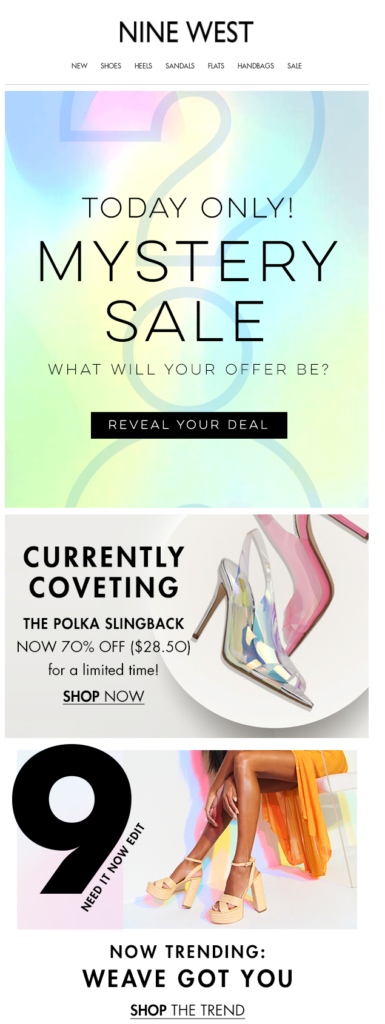
The email headline and subject line’s reference to a limited-period mystery sale creates a FOMO appeal. The straightforward CTAs with contextual email copy encourage users to check out the deals on the website.
Key Takeaways
- 50% of people buy from marketing emails at least once per month;
- Add a FOMO appeal to your subject line and email header;
- Use smart copywriting to persuade users to click your CTAs;
- Share ‘exact’ discounts or deal offers within the emails;
- Add terms and conditions, if any, within the footer of the email.
Learn more here: 10 Flash Sale Email Examples
Recommend Products with Personalized Emails
Ever get those emails saying, ‘Hey, we found more things you might like’? Those are product recommendation emails that work wonders to lure customers back. They look at what a customer bought before and what they’re into, then suggest other stuff they might like.
Here’s a great personalized email campaigns example from Skillshare:
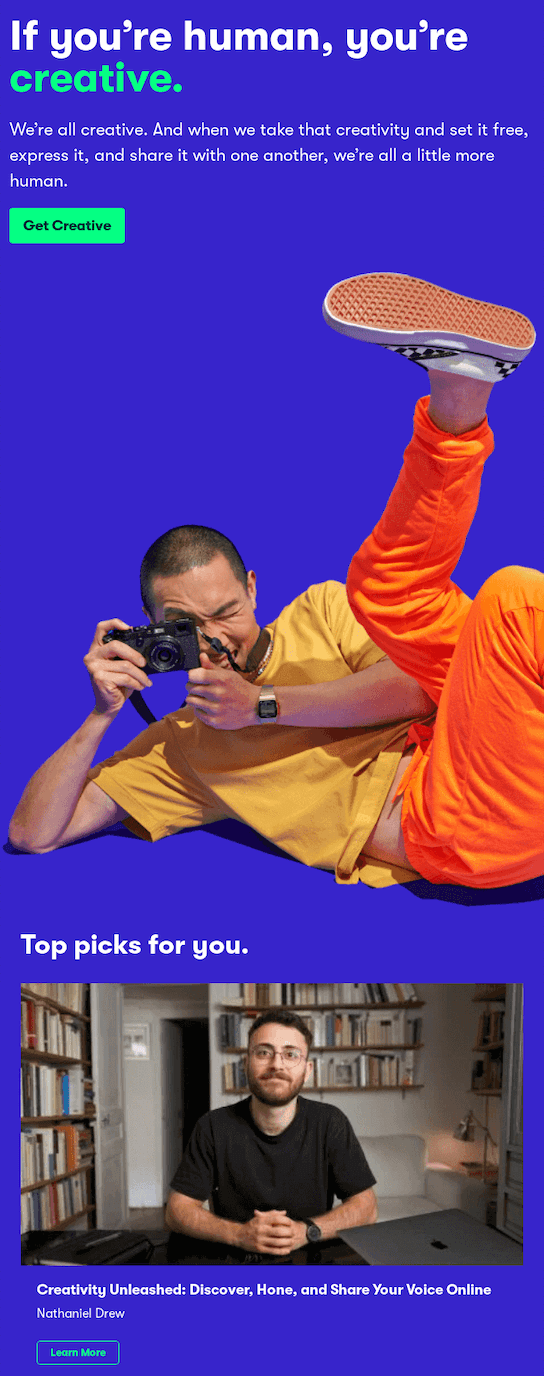
Skillshare frequently suggests new courses tailored to each user’s interests to ensure ongoing engagement and subscription renewals.
Yet, a simple but effective approach sets their recommendation emails apart – they provide insight into why these particular courses are highlighted.
Key Takeaways
- Product recommendations can account for up to 31% of e-commerce revenues;
- Use data on customer’s previous purchases and shown interest to recommend the products;
- Explain why these particular products are recommended;
- Add a separate CTA next to each product so customers can access it more easily.
Launch New Products with Exciting Announcements
New product launch email is a star email for ecommerce, acting as a digital siren announcing exciting arrivals to your audience. And the center piece of product launch email strategies.
These emails build buzz by showcasing the latest and greatest additions to your store, highlighting their unique features and benefits, and often motivating early purchases with exclusive discounts or early bird offers.
J. Lindeberg always make sure its’ subscribers are the first ones to know about new collections:
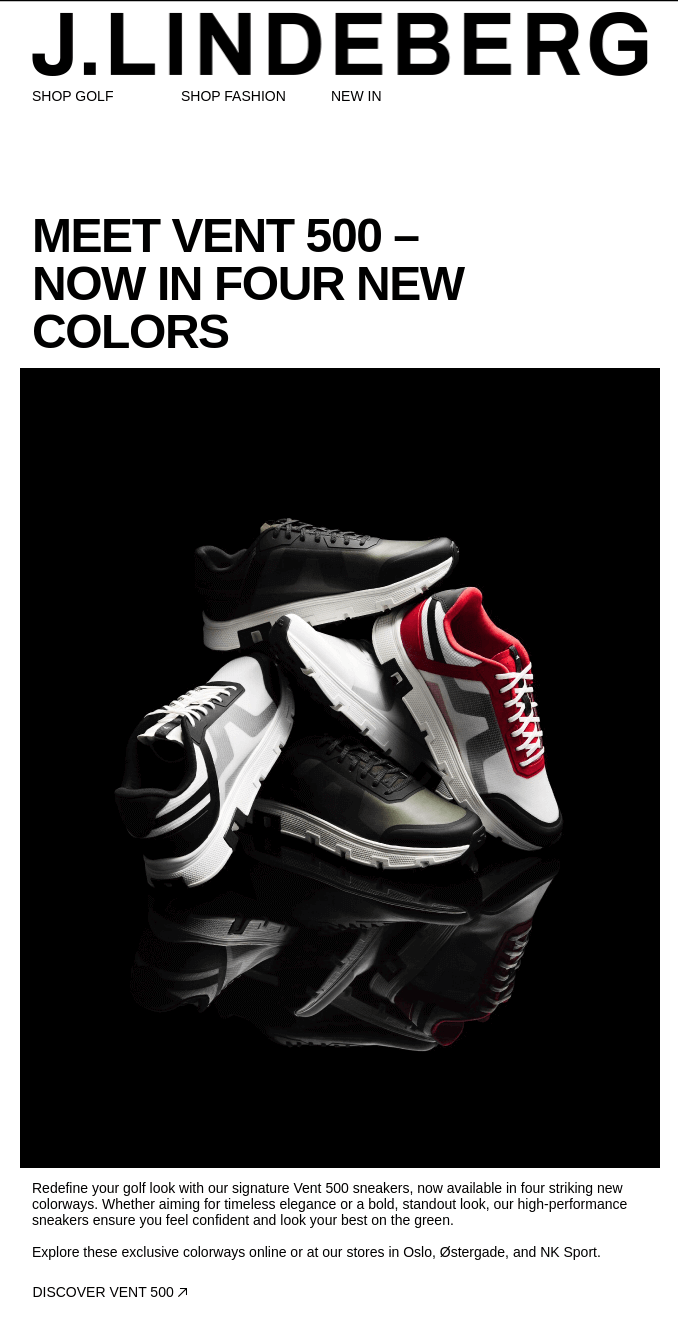
The brand makes their newest sneakers the centerpiece of email and rightfully so as the most compelling feature is their striking design. The recipients are then invited to explore the four new models and sport it on a golf field.
Key Takeaways:
- Center your entire email around the new product, treating it like the VIP it is;
- Use high-quality visuals that highlight the product’s unique appeal and create a sense of desire;
- Share the inspiration or problem that led to its creation;
- Make it clear what action you want subscribers to take, whether it’s learning more, pre-ordering, or snagging the first purchase.
If you’re caffeinated enough to learn more, here’s our top picks:
